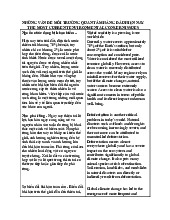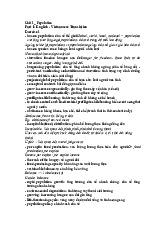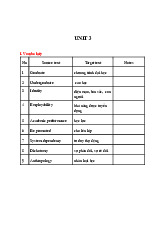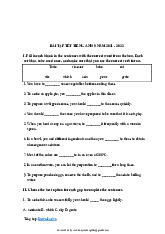








Preview text:
21.7.22 PRACTICE TEST 22 A. LISTENING SECTION 1 Questions 1-10 Complete the form below.
Write ONE WORD AND/ OR A NUMBER for each answer. OPENING A BANK ACCOUNT Example Answer
Application for a Current bank account
Type of current account: The 1 ' .......................... ' account
Full name of applicant: Pieter Henes
Data of birth: 2 ........................
Joint account holder(s): No
Current address: 3 .......................... Exeter
Time at current address: 4 ...................... .
Previous address: Rielsdorf 2. Utrecht. Holland
Telephone: work 5 ...................... .
Occupation: 6 ........................ .
Identity (security): Name of his 7.. ........................ : Siti
Opening sum: 8 € ....................... .. to be transferred from Fransen Bank, Utrecht
Statements: Every 9 ....................... ..
Requests: Supply information about the bank's 10 ......................... service. SECTION 2 (Questions 11-20) Questions 11-13
Choose the correct letter, A, B or C.
THE HISTORY OF ROSEWOOD HOUSE
11. When the writer Sebastian George first saw Rosewood House, he A thought he might rent it.
B felt it was too expensive for him.
C was nnsure whether to buy it.
12. Before buying the house, George had
A experienced severe family problems.
B struggled to become a successful author. C suffered a serious illness.
13. According lo the speaker, George viewed Rosewood House as
A a rich source of material for his books.
B a way to escape from his work.
C a typical building of the region. Questions 14-17 Label the map below:
Write the correct letter, A-J next to questions 14-17
ROSEWOOD HOUSE AND GARDENS
14 Pear Alley ..................
15 Mulberry Garden ................. 16 Shop ................. 17 TeaRoom ................ Questions 18-20 Complete the sentences below.
Write ONE WORD ONLY for each answer RIVER WALK
18 You can walk through the .......................... that goes along the river bank.
19 You can go over the ............................ and then into a wooded area.
20 On your way back, you could also go up lo the .............................. .. SECTION 3 (Questions21-30) Questions 21-24 Complete the sentences below.
Write NO MORE THAN THREE WORDS AND/ OR A NUMBER for each answer. MARKETING ASSIGNMENT
21. For their assignment, the students must investigate one part ofthe ....................
22. The method the students must use to collect data is ............................
23. In total, the students must interview ............................ people.
24. Jack thinks the music preferences of .......................... listeners are similar. Questions 25-30 Complete the notes below.
Write NO MORE THAN TWO WORDS for each answer.
Marketing Survey: Music Preferences Age group of interviewee • 25 or under • 45 or over Music preferences • Pop
• 25 ......................... . • Fdk • Easy listening
• 26 .......................... .
Medium for listening to music • Radb • CD •TV
• 2 7 .......................... . Source of music • Music shops
• 28 .......................... . Internet
Places for listening to music • Disco • Pub
• 29 ........................ . • Concert hall
• 30 ....................... . SECTION4 (Questions31-40) Questions 31-34
Choose the correct letter, A, B or C
IRELAND IN THE NEOLITHIC PERIOD
31. According to the speaker, it is not clear
A when the farming economy was introduced to Ireland.
B why people began to farm in Ireland.
C where the early Irish farmers came from.
32. What point does the speaker make about breeding animals in Neolithic Ireland?
A Their numbers must have been above a certain level.
B They were under threat from wild animals.
C Some species died out during this period.
33. What does the speaker say about the transportation of animals?
A Livestock would have limited the distance the farmers could sail.
B Neolithic boats were too primitive to have been used.
C Probably only a few breeding animals were imported.
34. What is the main evidence for cereal crops in Neolithic Ireland?
A the remains of burnt grain in pots
B the marks left on pots by grains
C the patterns painted on the surface of pots. Questions 35-40 Complete the sentences below.
Write NO MORE THAN TWO WORDS for each answer. STONE TOOLS
35. Ploughs could either have been pulled by ........................... or by cattle.
The farmers needed homes which were permanent dwellings.
36. In the final stages of axe-making ............................. and ............................ were necessary for grinding and polishing.
37. Irish axes were exported from Ireland to .......................... and England POTTERY MAKING
The colonisers used clay to make pots.
38. The ......................... of the pots was often polished to make them watertight.
39. Clay from ......................... areas was generally used.
40. Decoration was only put around the ......................... of the earliest pots.
B. GRAMMAR-VOCABULARY-LANGUAGE FUNCTIONS
Part 1. Choose the word or phrase which best completes each sentence.
1. As a(n) ______ girl, she found it difficult to socialize with other students in the class. A. reserved B. ashamed C. dynamic D. industrious
2. He is coming ______ a cold after a night out in the rain. A. down with B. up with C. away from D. across with
3. The bad weather caused serious damage to the crop. If only it ______ warmer. A. were B. had been C. has been D. was
4. It was so kind of her to put me______ while I was on a business trip in her town. A. down B. off C. up D. in
5. He didn’t know______ or stay until the end of the festival. A. if to go B. if that he should go C. to go D. whether to go
6. Mary: “I will never go mountaineering again.” Linda: “Me ______.” A. so B. too C. neither D. either
7. Mary: “Thanks a lot for your help.” John: “______.”
A. My happiness B. My excitement C. My delight D. My pleasure
8. My mother had to work 12 hours a day in a factory just to ______. A. make ends meet B. call it a day C. break the ice D. tighten the belt
9. Tom:“When are we leaving for the concert?” Kyle : “______.” A. No problem B. Certainly C. That’s right D. Straight away
10. New machinery has enhanced the company’s productivity and ______. A. competition B. competitor C. competitive D. competitiveness
Part 2. I Each of the following sentences has one mistake. Identify and correct it.
1. Most greetings cards are folding and have a picture on the front and a message inside. A B C D
2. Aloha is a Hawaiian word meaning ‘love’, that can be used to say hello or goodbye. A B C D
3. When you are writing or speaking English it is important to use language that includes A B
both men and women equally the same. C D
4. Globally and internationally, the 1990's stood out as the warmest decade in the history of weather A B C D records.
5. Of all the art-related reference and research library in North America, that of the Metropolitan Museum A B C
of Art in New York City is among the largest and most complete. D
Part 3. Provide the correct form of the words in brackets.
Antarctica is the only place on earth not yet ruined, still (1. touch______________) by the (2.
destroy______________) hand of man. Now, the virgin continent has become the source of yet another conflict
between scientists and (3. environment______________). There is a treaty (4. design______________) to
protect this continent which has only 8,000 inhabitants and most of them not permanent, but contains 70% of
the world's fresh water. Oil and minerals cannot be exploited, but what controls are there on the (5.
grow______________) number of scientists, explorers and even tourists? C. READING
Part 1. Read the text in each question. What does it say? Choose the best explanation for each text. On
the answer sheet, circle A, B, C or D. 1. Hi Penelope,
A) Monika has stayed in the hotel before.
The hotel is in a fantastic location
B) Penelope has already visited the hotel Monika is staying in.
- just as you described it.
C) Monika and Penelope are planning to go to the hotel
Thanks for recommending it. together next year
Liked it so much we've already booked for next year! Monika. 2.
Swansea University students
What does this notice say about Swansea University
and staff are free to use the students?
Libraries and its resources.
A) They don't have to pay to use the library resources.
B) They can use the library resources only if they ask the staff.
C) They don't need to get permission to use the library resources 3.
A) It is best to keep the medicine in the freezer. USE BEFORE
B) Keep the medicine away from heat and direct light. 10 JUL
C) You shouldn't take the medicine after 10th January
Store in a cool, dark place. 4. ° PLEASE DO NOT °
A) Do not ride your bicycle around the corner. CHAIN BICYCLES
B) These railings may damage your bike's chain. TO THESE RAILINGS
C) Do not lock your bike up to railings. ° THANK YOU ° 5. Jim, Barbara would like
Can you give me a lift to the conference
A) to drive Jim and herself to the conference.
next Friday? We could share the cost
B) to buy all the fuel needed for the conference trip.
of the petrol and I could meet you
C) Jim to pick her up somewhere in Bristol. in Bristol if necessary. Barbara
Part 2. Read the passage below and decide which option A, B, C or D best fits each space
In most of the earliest books for children, illustrations were an afterthought. But in the Caldecott "toy books"
which first (1)______ in 1878, they were almost (2)______ important as the lines of text, and occupied far more
space in the book. One can almost read the story from the dramatic action in the pictures. (3)______ then,
thousands of successful picture books have been published in the United States and around the world. In the
best, the words and illustrations seem to complement each other perfectly. Often a single person is responsible
(4)______ both writing and illustrating the book. One of (5)______, and certainly one of the most successful,
illustrator-authors was Dr. Seuss, (6)______ real name was Theodor Geisel. His first children's book, And to
Think That I Saw It on Mulberry Street, hit the market in 1937, and the world of children's literature was
changed forever. Seuss's playful drawings were a perfect complement to his engaging stories and (7)______
characters. In 1957, Seuss's The Cat in the Hat (8)______ the first book in Random House's best-selling series,
Beginner Books, written by Seuss and several (9)______ authors. These combine outrageous illustrations of
people, creatures, and plants, and playful stories written (10)______ very simple language.
From“The Complete Guide to the TOEFL Tests” byBruce Rogers 1. A. emerged B. happened C. appeared D. showed 2. A. most B. as C. less D. more 3. A. By B. Till C. Since D. Before 4. A. with B. at C. to D. for
5. A. the greater B. the greatness C. the great D. the greatest 6. A. whose B. who’s C. who D. whom 7. A. forgetting B. forgotten C. unforgettable D. forgetful 8. A. became B. would become C. had become D. has become
9. A. each other B. one another C. other D. another 10. A. at B. about C. in D. from
Part 3. Read the following passages and choose the correct answer.
Culture is a word in common use with complex meanings, and is derived, like the term broadcasting, from
the treatment and care of the soil and of what grows on it. It is directly related to cultivation and the adjectives
cultural and cultured are part of the same verbal complex. A person of culture has identifiable attributes, among
them a knowledge of and interest in the arts, literature, and music. Yet the word culture does not refer solely to
such knowledge and interest nor, indeed, to education. At least from the 19th century onwards, under the
influence of anthropologists and sociologists, the word culture has come to be used generally both in the
singular and the plural (cultures) to refer to a whole way of life of people, including their customs, laws, conventions, and values.
Distinctions have consequently been drawn between primitive and advanced culture and cultures, between
elite and popular culture, between popular and mass culture, and most recently between national and global
cultures. Distinctions have been drawn too between culture and civilization; the latter is a word derived not,
like culture or agriculture, from the soil, but from the city. The two words are sometimes treated as
synonymous. Yet this is misleading. While civilization and barbarism are pitted against each other in what
seems to be a perpetual behavioural pattern, the use of the word culture has been strongly influenced by
conceptions of evolution in the 19th century and of development in the 20th century. Cultures evolve or develop.
They are not static. They have twists and turns. Styles change. So do fashions. There are cultural processes.
What, for example, the word cultured means has changed substantially since the study of classical (that is,
Greek and Roman) literature, philosophy, and history ceased in the 20th century to be central to school and
university education. No single alternative focus emerged, although with computers has come electronic culture,
affecting kinds of study, and most recently digital culture. As cultures express themselves in new forms not
everything gets better or more civilized.
The multiplicity of meanings attached to the word made and will make it difficult to define. There is no
single, unproblematic definition, although many attempts have been made to establish one. The only non-
problematic definitions go back to agricultural meaning (for example, cereal culture or strawberry culture) and
medical meaning (for example, bacterial culture or penicillin culture). Since in anthropology and sociology we
also acknowledge culture clashes, culture shock, and counterculture, the range of reference is extremely wide.
1. According to the passage, the word culture________________.
A. is related to the preparation and use of land for farming
B. comes from a source that has not been identified
C. develops from Greek and Roman literature and history
D. derives from the same root as civilization does
2. It is stated in paragraph 1 that a cultured person_________________.
A. has a job related to cultivation
B. does a job relevant to education C. D.
takes care of the soil and what grows on it
has knowledge of arts, literature, and music
3. The author remarks that culture and
civilization are the two words that_ ________________.
A. share the same word formation pattern
B. have nearly the same meaning
C. are both related to agriculture and cultivation
D. do not develop from the same meaning
4. It can be inferred from the passage that since the 20th century__________________.
A. schools and universities have not taught classical literature, philosophy, and history
B. classical literature, philosophy, and history have been considered as core subjects
C. classical literature, philosophy, and history have not been taught as compulsory subjects
D. all schools and universities have taught classical literature, philosophy, and history
5. The word “attributes” in paragraph 1 most likely means________________. A. fields B. qualities C. aspects D. skills
6. The word “static” in paragraph 2 could best be replaced by “________________”. A. unchanged B. balanced C. regular D. dense
7. Which of the following is NOT stated in the passage?
A. Anthropology and sociology have tried to limit the references to culture.
B. Distinctions have been drawn between culture and civilization.
C. The use of the word culture has been changed since the 19 th century.
D. The word culture can be used to refer to a whole way of life of people.
8. It is difficult to give the definitions of the word culture EXCEPT for its_ _______________.
A. agricultural and medical meanings
philosophical and historical meanings B.
C. historical and figurative meanings
D. sociological and anthropological meanings
9. Which of the following is NOT true about the word culture?
A. It differs from the word civilization.
B. It evolves from agriculture.
C. Its use has been considerably changed.
D. It is a word that cannot be defined.
10. The passage mainly discusses______________.
A. the multiplicity of meanings of the word culture
B. the distinction between culture and civilization
C. the figurative meanings of the word culture
D. the derivatives of the word culture
Part 4. Read the text and decide if each sentence is True or False
American movies create myths about college life in the United States. These stories are entertaining, but they
are not true. You have to look beyond Hollywood movies to understand what college is really like.
Thanks to the movies, many people believe that college students party and socialize more than they study.
Movies almost never show students working hard in class or in the library. Instead, movies show them
eating, talking, hanging out, or dancing to loud music at wild parties. While it is true that American students
have the freedom to participate in activities, they also have academic responsibilities. In order to succeed, they
have to attend classes and study hard.
Another movie myth is that athletics is the only important extracurricular activity. In fact, there is a wide
variety of nonacademic activities on campus such as special clubs, service organizations, art, and theater
programs. This variety allows students to choose what interests them. Even more important, after graduation,
students’ résumés look better to employers if they list a few extracurricular activities.
Most students in the movies can easily afford higher education. If only this were true! While it is true that
some American college students are wealthy, most are from families with moderate incomes. Up to 80% of
them get some type of financial aid. Students from middle and lower-income families often work part-time
throughout their college years. There is one thing that many college students have in common, but it is not
something you will see in the movies. They have parents who think higher education is a priority, a necessary
and important part of their children's lives.
Movies about college life usually have characters that are extreme in some way: super athletic, super
intelligent, super wealthy, super glamorous, etc. Movies use these stereotypes, along with other myths of
romance and adventure because audiences like going to movies that include these elements. Of course, real
college students are not like movie characters at all.
So the next time you want a taste of the college experience, do not go to the movies. Look at some college
websites or brochures instead. Take a walk around your local college campus. Visit a few classes. True, you may
not be able to see the same people or exciting action you will see in the movies, but you can be sure that there
are plenty of academic adventures going on all around you!
From “Read and Reflect” by Jayme Adelson-Goldstein with Lori Howard
1. You should see college movies to understand college life.
2. Not all extracurricular activities are students’ academic responsibilities.
3. Most college students’ families are not well-off.
4. American parents believe in the necessity of higher education in their children's lives
5. Many American students have to work part-time throughout their college years because they can earn money for their expenses D. WRITING
Part 1. Finish each of the following sentences in such a way that it means exactly the same as the sentence printed before it.
1. David was narrowly defeated and blew his own chance of becoming a champion.
- As a result .................................................................................. ......................................
2. "I would be grateful if you could send me further details of the job,” he said to me.
- He politely ................................................................................. ......................................
3. In all probability, he is coming.
- He is ................................................................................. ......................................
4. His rude behaviour is too much for me.
-. I can’t ................................................................................. ......................................
5. The population of Spain is increasing.
- The population of Spain is ................................................................................. ...................................... Part 2.
This is part of a letter you receive from an Australian friend.
Could you give me some advice? I want to travel around your country for a month. Where should I go? What should I see?
Now write a letter of about 100 words to answer your friend’s questions. Part 3.
Write a paragraph of about 160 words on the following topic:
What is a problem in the place where you live? What should be done to solve this problem?




